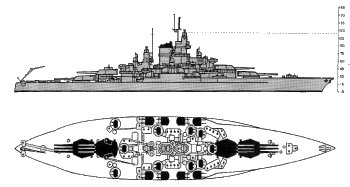![]() The Pacific War Online Encyclopedia
The Pacific War Online Encyclopedia
|
| Previous: Tenga | Table of Contents | Next: Tenryu Class, Japanese Light Cruisers |
 ONI 222 |
| Tonnage | 32,600 tons standard displacement |
| Dimensions | 624' by 97'6" by 30'2" 190.20m by 29.72m by 9.2m |
| Maximum speed | 21.5 knots |
| Complement | 1401 |
| Aircraft | 2 catapults 3 seaplanes |
| Armament | 4x3 14"/50
guns 12x1 5"/51 guns 8x1 5"/25 AA guns |
| Protection | About 9660 tons or 30% of displacement: 13.5" (343mm) belt tapering to 8" (203mm) below the waterline 2" STS + 1.75" STS + 1.75" NS = 4.2" (51mm STS + 44mm STS + 44mm NS = 107mm) armor deck 3" STS + 1.75" STS + 1.75" NS = 5.3" (76mm STS + 44mm STS + 44mm NS = 134mm) armor deck over magazines 4.5" STS + 1.75" MS = 5.5" (114mm STS + 44mm MS = 158mm) over steering spaces 1" STS + 0.5" MS =1.3" (25mm STS + 13mm MS = 33mm) splinter deck 13" (330mm) bulkheads tapering to 8" (203mm) below waterline 18"/7"STS/10"/9" (457mm/178mm STS/254mm/229mm) turret 13" (330mm) barbettes Splinter protection for 5"/25 guns 16"/6" (406mm/152mm) conning tower 9" (229mm) uptakes 17'3" (5.3m) underwater protection consisting an outer void compartment, two liquid compartments, and an inner void compartment with a holding bulkhead. This was designed to withstand a 400 lb (181 kg) explosive charge. |
| Machinery |
4-shaft turbo-electric
(26,800
shp) 8 Babcock & Wilcox boilers |
| Bunkerage | 1903 tons fuel oil |
| Range | 5240 nautical miles (9700 km) at 12 knots 8000 nautical miles (14,800 km) at 10 knots |
| Sensors |
CXAM1 air search radar |
| Modifications |
Tennessee: Early 1942: Added 4x4 1.1" antiaircraft
guns and
16x1 20mm
Oerlikon
antiaircraft guns. Two 5"/51 guns removed and FC and SC radar added.
1942-6: 2x4 1.1" guns added. 1942-9: Began major modernization. Beam increased to 114' (34.7m) with torpedo blisters. All 5"/51 guns removed. 4x2 5"/38 dual-purpose guns added. Light antiaircraft consisted of 10x4 40mm guns and 43x1 20mm guns. Conning tower replaced with 5" (127mm) tower. Internal subdivision improved. Splinter deck and turret roof armor increased to 7" (178mm). Final displacement 39,500 tons and speed reduced to 20.6 knots. California: Resembled the modernized Tennessee following
repairs from
1942-6 to 1944-1. However, light antiaircraft was 14x4
40mm guns, 40x2
20mm guns. |
The Tennessees were
completed in 1920-1921. The Navy initially considered a radical
design
with armor sloped by as much as 45 degrees ("Ironsides"), but
abandoned this due to
stability concerns and chose a conventional design based closely
on the
New Mexicos.
They were
good ships, with turboelectric drive that improved subdivision.
They
were surprisingly
maneuverable, being able to reach full speed in just three minutes
and
with a
tactical diameter of 700 yards.
The most significant new feature of the ships was a novel underwater protection system, based on extensive caisson experiments. The system consisted of four compartments separated by thin bulkheads. The outermost and innermost compartments were void while the middle compartments were liquid-filled, and the bulkheads were designed to resist deformation as much as possible and then tear with as little fragmentation as possible. The effect was that most of the force of a torpedo explosion would be expended in the void spaces while the liquid layers absorbed fragments, leaving the inntermost holding bulkhead intact to prevent flooding of the spaces beyond. The system was judged capable of resisting a 400 lb (181kg) explosive charge. It was the best engineered system in the world at the time, and its principles were duplicated on all subsequent U.S. battleships as well as many foreign battleships.
Another improvement was the use of turrets that could
elevate their guns to 30 degrees, which increased their range by
about
40% over earlier ship classes (which could only elevate their guns
to
15 degrees). This was judged valuable enough that the older ships
were
eventually modified to elevate their guns to 30 degrees as well.
Tennessee was lightly damaged in the Pearl Harbor attack, taking just two bomb hits, though her aft section was badly damaged by flaming oil from the Arizona. While under repair, Tennessee added considerable antiaircraft armament and radar. Once new battleships began arriving in the Pacific, she was taken in hand for a major modernization that left her with a superstructure resembling South Dakota.
The two torpedoes that hit California at Pearl Harbor failed to penetrate her torpedo defense system. However, she had ten or twelve access hatches to her torpedo defense voids opened for inspection, which allowed water to flood freely into the ship. She was later raised and repaired, undergoing her own extensive modernization, and participated in the final offensives of the war.

|

|

|
References
The Pacific War Online Encyclopedia © 2007, 2009-2010, 2012, 2016 by Kent G. Budge. Index